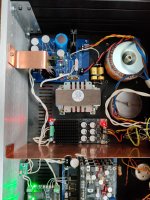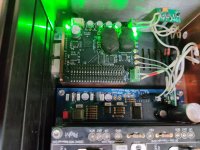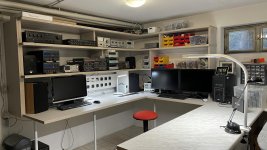I have 4 capacitors at the output. The outputs from all four capacitors are connected to the XLR connectors (Pins 2,3). The outputs from only two capacitors (from the POS out) are connected to the RCA connectors central pin. The GND pin of the RCA is connected to the Common (GND signal). It can't be connected otherwise if you don't have an output transformer, so you have just 1/2 voltage (1,2VRMS) in SE mode. If the balanced / unbalanced preamplifier has a potentiometer at the input, capacitors/transformers must be used at the DAC output regardless of whether the potentiometer is followed by capacitors at the input of the preamplifier. Direct connection without capacitors or transformers is possible only with a real balanced preampifier or amplifier that does not have a potentiometer at the input, but the inputs are connected directly to the active balanced circuit. In this case 2.7VDC at DDDAC outputs are common mode and are canceled.
If you want to use DDDAC without an output transformer and only in SE mode, two capacitors on the POS out are enough. If you bought 4 capacitors, and you don't want balanced out, connect two in parallel and then to the RCA central pin. The bass is a little better with larger output capacitors.
An alternative to capacitors and transformers are active circuits for BAL / SE conversion, for example Broskie cathode follower with tubes, or operational amplifiers (I do not recommend), or something else, for example with discrete transistors. I think it's best to stick to the transformer output, you just need to find out what the problem is with that DDDAC.
If you want to use DDDAC without an output transformer and only in SE mode, two capacitors on the POS out are enough. If you bought 4 capacitors, and you don't want balanced out, connect two in parallel and then to the RCA central pin. The bass is a little better with larger output capacitors.
An alternative to capacitors and transformers are active circuits for BAL / SE conversion, for example Broskie cathode follower with tubes, or operational amplifiers (I do not recommend), or something else, for example with discrete transistors. I think it's best to stick to the transformer output, you just need to find out what the problem is with that DDDAC.
Last edited:
Direct connection without capacitors or transformers is possible only with a real balanced preampifier or amplifier that does not have a potentiometer at the input, but the inputs are connected directly to the active balanced circuit (or input transformer).
Upgrading the DDDAC is a odd hobby
Here is a review of my updates of DDDAC shunt regulator and power supply. But first I have to explain why I started my upgrades of my power supplies, having BBB-Hermes- cronus In my system for many years, and being very satisfied with the sound signature. But also, in the knowing it was going to be obsolete and was not the easiest to update. I then moved to Raspberry pi-Fifopi combo. After the change, I was not totally satisfied with the high notes and transients, they came out very hard and annoying. A track that sounds very annoying if something is wrong, is Quincy Jones “Q’s jook joint”-you put a move on my heart” Track 4. Tamia’s voice on the track is very revealing, she will tell you if anything is wrong in the top end. I cornered the problem down to be the standard DDDAC 5v power supply not being powerful enough for the pi setup. And the fifopi to close to the pi. The first thing I did was to make a cobber shield between the pi and fifo, this really helped the attack and precision of the transient response. I recommend users that also have this setup to move the fifopi away from the Raspberry pi, one way or another. Next step was to upgrade the 5v power supply to Ian Canada 5v supply powering the pi. This was another positive step. Suddenly the snapping sound in left channel of Elvis Presley’s “Fever” did not sound as hitting an old fish with a wooden spoon, but as what I really is. Next step was to upgrade my 12v supply, and would not have come through this operation without the help from Doede, Eduard and Mbernnwa. Thanks again. The 12v upgrade is in my opinion not a night and day experience, but still a positive step toward a “analogue” reproduction. The 12v upgrade made the sound stage of a stereo recording more precise and ambient. After making new updates in my system, I start with Phil Spector “Back to mono” I find mono recordings very reviling in a stereo setup, but here the big bonus was the stereo reproduction. Then it came to the 5v shunt regulator on the blue motherboard. I have had the Ldovr 5v there for many years, a dear friend of me gave me a 5v Tent shunt regulator. After installation, I can only agree 100% with Doede’s review in earlier post. Upgrading the DDDAC is a odd hobby, my wife keeps telling me, and somehow, I must agree with her. But here I go again, Eduard was so kind to send me two Bourdere 0,1H Chokes to put in series =162mh/2.6 ohm to try instead of the Mundorf 15mh+1.32 ohm I was using in my 12v supply. The Nos chokes from Eduard made the soundstage now even more precise and ambient. Female voices has more texture, on Louis Armstrong & Duke Ellington “The making of the great summit” track 3. Louis Armstrong voice and trumpet comes out just beautiful, I can recommend this lovely recording, you have hands clapping, footsteps, whiskey bottle opening and a great soundstage. Just loving it😊 In my system the cobber and 5v upgrade has the biggest effect. But I do not regret the 12v upgrades they are here to stay.
Here is a review of my updates of DDDAC shunt regulator and power supply. But first I have to explain why I started my upgrades of my power supplies, having BBB-Hermes- cronus In my system for many years, and being very satisfied with the sound signature. But also, in the knowing it was going to be obsolete and was not the easiest to update. I then moved to Raspberry pi-Fifopi combo. After the change, I was not totally satisfied with the high notes and transients, they came out very hard and annoying. A track that sounds very annoying if something is wrong, is Quincy Jones “Q’s jook joint”-you put a move on my heart” Track 4. Tamia’s voice on the track is very revealing, she will tell you if anything is wrong in the top end. I cornered the problem down to be the standard DDDAC 5v power supply not being powerful enough for the pi setup. And the fifopi to close to the pi. The first thing I did was to make a cobber shield between the pi and fifo, this really helped the attack and precision of the transient response. I recommend users that also have this setup to move the fifopi away from the Raspberry pi, one way or another. Next step was to upgrade the 5v power supply to Ian Canada 5v supply powering the pi. This was another positive step. Suddenly the snapping sound in left channel of Elvis Presley’s “Fever” did not sound as hitting an old fish with a wooden spoon, but as what I really is. Next step was to upgrade my 12v supply, and would not have come through this operation without the help from Doede, Eduard and Mbernnwa. Thanks again. The 12v upgrade is in my opinion not a night and day experience, but still a positive step toward a “analogue” reproduction. The 12v upgrade made the sound stage of a stereo recording more precise and ambient. After making new updates in my system, I start with Phil Spector “Back to mono” I find mono recordings very reviling in a stereo setup, but here the big bonus was the stereo reproduction. Then it came to the 5v shunt regulator on the blue motherboard. I have had the Ldovr 5v there for many years, a dear friend of me gave me a 5v Tent shunt regulator. After installation, I can only agree 100% with Doede’s review in earlier post. Upgrading the DDDAC is a odd hobby, my wife keeps telling me, and somehow, I must agree with her. But here I go again, Eduard was so kind to send me two Bourdere 0,1H Chokes to put in series =162mh/2.6 ohm to try instead of the Mundorf 15mh+1.32 ohm I was using in my 12v supply. The Nos chokes from Eduard made the soundstage now even more precise and ambient. Female voices has more texture, on Louis Armstrong & Duke Ellington “The making of the great summit” track 3. Louis Armstrong voice and trumpet comes out just beautiful, I can recommend this lovely recording, you have hands clapping, footsteps, whiskey bottle opening and a great soundstage. Just loving it😊 In my system the cobber and 5v upgrade has the biggest effect. But I do not regret the 12v upgrades they are here to stay.
Thanks for these insights! Which oscillators do you have on your FiFoPi? And what's the black stuff on them?
The oscillators is the accusilicon, and the black stuff is Butylband beidseitig stark klebend | WURTH
...the black stuff is Butylband beidseitig stark klebend | WURTH
...to keep the oscillator temperature more stable? Or something else?
I put it on to damp vibrations, when a/b testing upgrades the Dac is very close to my speakers with the cabinet open. The temperature issue is not the prime reason.
Hmmm... I guess damping mechanical vibrations would require a bit of mass coupled to a resistive element to dissipate the vibration energy.
True is your conclusion.. but tapping with a nail on the oscillator, made me use this solution as a quick fix.
Last edited:
@Doede (mostly...)
I'm trying to implement a DDDac with 4 inputs.
- Input #1 Build-in SOC-board (usually some kind of Raspberry Pi)
- Input #2 Build-in SOC-board (usually some kind of Raspberry Pi with another configuration)
- Input #3 Build-in WaveIO for USB-connection
- Input #4 S/PDIF using the build-in WM8804-chip on the Mainboard
All inputs is normally routed into 3*4-way relay-boards and then through an Ian FiFoPi.
A little simple question... Should I break out the I2S-signal from the WM8804-chip before or after the 3*100 Ohm resistors R9, R10 and R11?
The WM8804 I2S-signal will go into the relay-boards, FiFoPi and then end back in the DDDac through the I2S input connector pins. Not through the 74VHCT244AM-chips second I2S-input.
Thanks...
I'm trying to implement a DDDac with 4 inputs.
- Input #1 Build-in SOC-board (usually some kind of Raspberry Pi)
- Input #2 Build-in SOC-board (usually some kind of Raspberry Pi with another configuration)
- Input #3 Build-in WaveIO for USB-connection
- Input #4 S/PDIF using the build-in WM8804-chip on the Mainboard
All inputs is normally routed into 3*4-way relay-boards and then through an Ian FiFoPi.
A little simple question... Should I break out the I2S-signal from the WM8804-chip before or after the 3*100 Ohm resistors R9, R10 and R11?
The WM8804 I2S-signal will go into the relay-boards, FiFoPi and then end back in the DDDac through the I2S input connector pins. Not through the 74VHCT244AM-chips second I2S-input.
Thanks...
@mroerup
I thought about it as well to do this. But I left it, as it will give me always a reference for how a normal DAC sounds compared to any I2S source through the FiFoPi 😛
but that has more to do with listening tests as with enjoying music. I am not listening through spdif, so no big issue of course.
to your question, I would pick it up before the 100 Ohm, If you do it afterwards it will form a RC low pass filter with a unknown pF value ?? so to be sure I would not leave them in.
You do realize that the galvanic isolation is gone if you select spdif, right?
I solved this by also switching the GND signal wire of the source, not only the I2S signal. by doing this I keep true galvanic isolation with the sources which are not playing...
I thought about it as well to do this. But I left it, as it will give me always a reference for how a normal DAC sounds compared to any I2S source through the FiFoPi 😛
but that has more to do with listening tests as with enjoying music. I am not listening through spdif, so no big issue of course.
to your question, I would pick it up before the 100 Ohm, If you do it afterwards it will form a RC low pass filter with a unknown pF value ?? so to be sure I would not leave them in.
You do realize that the galvanic isolation is gone if you select spdif, right?
I solved this by also switching the GND signal wire of the source, not only the I2S signal. by doing this I keep true galvanic isolation with the sources which are not playing...
Yeah, I actually did give it some thoughts...but maybe not enough!
If I don't connect the GND from the DDDac to the relay-boards when selecting the WM8804 I2S-output (S/PDIF input), will the signal even flow into the FiFoPi's dirty-side?
I mean electricity only suppose to flow in a connected circuit, right? I have however seen people NOT connecting GND when using I2S-signals.
I was planing to connect all 3 I2S-signals + GND from the Pi- and the WaveIO boards and into the FiFoPi's dirty-side.
If I don't connect the GND from the DDDac to the relay-boards when selecting the WM8804 I2S-output (S/PDIF input), will the signal even flow into the FiFoPi's dirty-side?
I mean electricity only suppose to flow in a connected circuit, right? I have however seen people NOT connecting GND when using I2S-signals.
I was planing to connect all 3 I2S-signals + GND from the Pi- and the WaveIO boards and into the FiFoPi's dirty-side.
as said, you need to switch the gnd as well but only when listening to the spdif - with spdif you will not have isolation. alternatively you need an extra spdif-I2S board
Thanks Doede. I will first try the "non-isolated" method and if I'm not satisfied, I will implement a S/PDIF>I2S board. I actually have one in storage...
Attachments
- Home
- Source & Line
- Digital Line Level
- A NOS 192/24 DAC with the PCM1794 (and WaveIO USB input)


